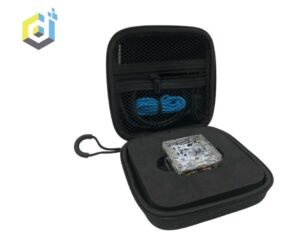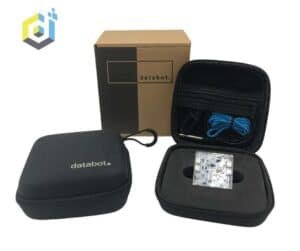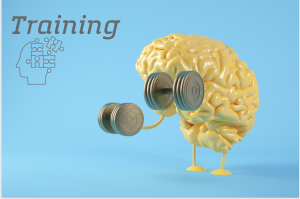Meet Hiren Thakkar

databot Talks
“databot Talks” are interviews with educators sharing stories about their love of teaching and their experiences using databot as a tool for learning. In this post Sakshi Baid, a Curriculum Specialist and Science Communicator at databot, speaks with Hiren Thakkar, a Master Trainer with the Agastya Foundation in India. Hiren has been with the Foundation now for over eight years and began his teaching career at Agastya.
The Agastya International Foundation, founded in 1999 by Ramji Raghavan, is an Indian education trust and non-profit organization based in Bangalore, India whose mission is “to spark curiosity, nurture creativity and build confidence” among economically disadvantaged children and teachers in India.
Sakshi Baid sat down with Hiren in September of 2023 and learned about his experiences with the Foundation, his students, his trainees, and databot.

Sakshi Baid is a Science Communicator and Curriculum Specialist at databot.
Background on Hiren and the Agastya Foundation
How long you have been teaching ? How did you start you career in teaching?
I began my career at Agastya and have been working with Agastya from last 8 and half years. I am at the post now of Master Trainer where I train instructors to work in the Agastya environment. After joining Agastya my interest in learning science has increased – I have started feeling science around me!
What do you like about the learning philosophy of Agastya?
- Hands-on learning
- Group activities done by students which develop teamwork and collaborative abilities, confidence, leadership, and creativity.
- Innovative ideas are developed by students to solve problems they are actually facing in their day-to-day life.

The Art and Innovation Hub at the Agastya Foundation’s 172 Acre Learning Campus. The campus is home to more than 20 labs and serves up experiential learning to some 600 students each day.

Are you still teaching at Agastya? What is your work environment like – do you show up somewhere in a van, bicycle or scooter?
I don’t work with students right now as I am a Master Trainer, but I train instructors and teachers of Agastya to work with students.
In rural areas these instructors show up in a van or a bike and do hands-on activities. Model demonstration is also done by them.
Hands-on with Hiren & Agastya

Agastya’s reach extends throughout the India subcontinent.
As a teacher, what is your favorite memory with a student?
In 2016 , at Baroda, I visited my first science fair. People from different institutes and organizations were there. We also had a fun science experiment booth there. Soon, a student from another booth joined our stall and and started doing our activities. The curiosity and engagement that I saw that time was overwhelming for me.
Also during COVID times, we did a number of online sessions here in Gujarat, specially for rural areas. I still remember there was one student who was not very interested in learning science. He used to join the online meeting and not pay attention. Then, in 2021, we conducted science fair online and that particular student made his own model to solve a problem his parents were facing in their farm. He made a gun which would scare off monkeys from entering the farm upon hearing the sound of bullets. He secured the prize for this model at the state level.
What can you tell me about Agastya Instructors?
Not every instructor is from teaching background. They are from varied fields of science, arts, and commerce. And initially they have to start from zero to know about experiential learning according to the norms of Agastya. They mostly have theoretical background only so introducing them to experiential learning is very important.
Despite these instructors being from a range of different backgrounds the ultimate goal is for them to take their knowledge to students in an engaging and fun way. So we begin with experiential learning training. We have our coursework in which real-time training is given to the instructors. We monitor them and improve their teaching skills over time.

What do you think is the most important thing to help students be successful in their career?

Whatever students are learning should be in the form of skills that will help them in the future according to their interests. Skills should be useful for them and contribute to society as well.
Many students from Agastya are admitted to the top institutes of India like IITs and we can’t be happier than knowing this. These were the students who had little hope for learning science and technology as they were from rural areas. Now we see these students in many prestigious places.
This is real success for us.
databot Comes to Agastya
How long you have been using databot?
We have been using databot for about a year now. It has many benefits and I find it fascinating.
For example, humidity measurements and altitude measurements. It’s very easy to measure height with databot even at very high altitudes (more that 50 feet as well) and I find that amazing.
We now use databot in our 2nd semester and use it frequently with students over this 4-5 month period.
We also conducted a science fair last year in Gujarat and there was a booth for databot. Students conducting the demonstrations as well as the audience enjoyed working with databot. This was such a unique experience for students to use this tech device for explaining science.

A science fair in Gujarat provided Agastya students the opportunity to engage visitors with live sensor data explorations using databot.

What are some of your favorite teaching tools?
The models we use which are very engaging – I love such tools. Even databot is one of those teaching tools which engages students and invokes their curiosity.
How much time does it take a new student to learn and engage with databot?
From the sessions I have observed student’s interest in learning science increases when they are using databot. Since we frequently work with students from rural areas, learning to use tech devices can take a little time. Students from these areas rarely have mobile phones even.
So for such students it takes time to get used to any technology, but databot is easy. After learning how to use it, students get very eager to explain activities with databot.


Tell me about databot and the recent Science Fair at Gujarat!
A week before the science fair we completed training students. They did 14 activities related to the databot Sensor Starters with sensors exploring topics like acceleration, humidity, carbon dioxide, temperature, sound intensity, light intensity, the UV index, and others.
This project was taken to the District Level where students won the prize with databot. Teachers were there as well and they were very curious to learn more about the device.
Conclusion

Regarding databot, we feel we are just getting started. What do you think – how does it help to inspire students in learning science?
databot makes students excited about exploring data. After using it I have seen students enjoying taking readings of humidity, UV index, and more. Students even begin experimenting in their own way with databot.
Here is an example. Over a series of rainy days there was leakage in the class walls so students, all by themselves, decided to measure humidity levels by removing a block of wall and placing the databot there. I’ve also seen them do temperature sensing experiments using the temperature probe in oil and water.
Students enjoy their databot classes.
From the sessions I have observed student’s interest in learning science increases when they are using databot.
— Hiren Thakkar
About databot™
databot™ learning solutions transform the way K12 students experience data, science, and technology. In the classroom, after-school, and in the home, our mission is to make interacting with and understanding data a beautiful, fun, and ubiquitous experience. One that crosses the traditional boundaries of all learning environments. The world is driven by data and we are driven to teach future generations how to use it for good. We create data powered technology and brilliant learning activities that empower students everywhere to think deeply, explore with passion, and solve our planetary scale challenges.
Contact us to share ideas, comments, and learn more about our products and mission.

databot Rocks! Get Yours Today!
-
databot
databot Single
$189.99 Select options This product has multiple variants. The options may be chosen on the product pageRated 0 out of 5 -
databot
databot – Twin Pack
$375.00 Select options This product has multiple variants. The options may be chosen on the product pageRated 0 out of 5 -
databot
databot – Class Pack
$1,850.00 Select options This product has multiple variants. The options may be chosen on the product pageRated 0 out of 5 -
databot
databot Training Modules
$399.00 – $1,000.00 Select options This product has multiple variants. The options may be chosen on the product pageRated 0 out of 5




